The decision to take a late summer or fall cutting of alfalfa should be considered carefully. A farm should evaluate current forage needs, economics, stand health, and timing to make the best decision for their individual situation. Although the need for more forage may override some other factors, the timing of harvest is still critical. Fall harvest decisions will impact both short-term forage quality and availability, and potentially affect the long-term viability and productivity of the stand. Volatile weather conditions during the winter and spring months may result in diminished plant health and vigor, while suboptimal stand health and poor soil fertility management further increase the risk of winterkill.
Alfalfa Dormancy and Regrowth
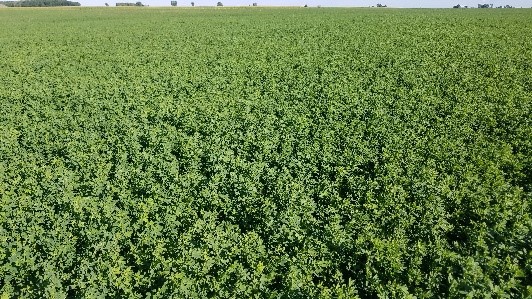
As temperatures fall and day length becomes shorter during late summer, alfalfa plants begin to prepare for winter by storing carbohydrates and proteins in their taproot. In addition, alfalfa plants change their cellular structure and composition to survive freezing temperatures. Accumulated root energy and stored nutrients are used to maintain the plant during winter, as well as supply the necessary resources required during the first week to ten days of early ‘green-up’ growth until photosynthetic processes can take over.
Alfalfa root carbohydrate and protein root stores can be compromised if temperatures during the winter months rise enough for the plants to break dormancy prematurely and begin establishing new growth. If cold conditions follow an unseasonable warm-up period, the plants may not have enough root stores for a vigorous second spring regrowth attempt. Therefore, any fall harvest strategy that compromises the accumulation of root reserves increases the stand’s risk of winter injury, slow spring recovery, and reduced stand vigor, particularly during unseasonably warm winters.
Timing Fall Alfalfa Harvest Based on Growing Degree Days
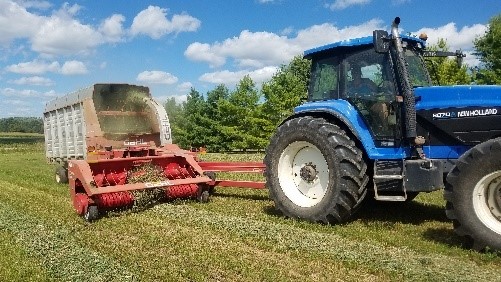
Research in the northern United States and Canada indicates alfalfa requires 500 growing degree days (GDD, base 41°F) between the final harvest of the season and a killing frost of 24°F for sufficient regrowth to enhance the probability of winter survival and full yield potential the following spring. As a result, harvest should occur when there are more than 500 GDDs remaining in the season, allowing for root carbohydrate replenishment, or less than 200 GDDs remaining, so plant regrowth is insignificant and previously accumulated root reserves are conserved.
Utilizing 42 years of historical weather data, Dan Undersander, retired UW-Madison Forage Specialist, determined the middle of September through the middle of October is the highest risk period to cut alfalfa in southern Wisconsin (data for Beloit and Lancaster). In northern Wisconsin, (data from Eau Claire, Marshfield and Plymouth) data suggests harvesting alfalfa the last half of September creates the highest risk, with a low probability of accumulating either more than 500 GDD or less than 200 GDD. Delaying harvest until mid-October is often safer for all areas of the state, regardless of the occurrence of frost. View maps detailing the probabilities of accumulating more than 500 GDD or less than 200 GDD.
Additional Alfalfa Harvest Considerations
Farmers should consider individual field characteristics when making a final decision on whether to harvest a fall cutting. Overall management of the fields during the growing season may impact the risk and reward of fall harvest decisions. Evaluating the following factors can help you determine the best strategy.
Harvest Frequency
Fields that have been managed with a harvest interval of 30 days or less often do not replenish their full root energy reserves between cuttings. Therefore, taking a late season fourth/fifth cut in these fields places the alfalfa stand at greater risk for winterkill than taking the third/fourth cut in fields with a longer harvest interval. However, alfalfa genetics should be considered when making fall harvest decisions. Many current alfalfa varieties, particularly with those with good disease resistance and winter hardiness, are designed to withstand more intense cutting schedules than the varieties of the past.
Stand Health
Alfalfa stands between 18 and 36 months of age are more tolerant of late season cuttings due to better crown health. More recently established stands are less likely to have accumulated damage from wheel traffic and disease incidence, rendering them more tolerant to environmental stresses than older stands.
Soil Fertility Management
Proper management of soil pH and fertility will improve the winterhardiness of alfalfa stands. Maintaining optimal potassium levels has been shown to improve alfalfa winterhardiness and tolerance to late cuttings. Alfalfa plants require potassium for many essential plant processes, including activation of enzymes, synthesis of carbohydrates and protein, and water regulation.
Soil fertility should be managed throughout the season. Topdressing alfalfa with potassium in late fall typically will have little impact on that year’s overwintering potential. Potassium can be absorbed by the plant in greater quantities or higher concentrations than required (luxury consumption) for normal growth. As a result, care must be taken to not overfertilize the crop. Feeding forages high in potassium to calving or newly fresh cows can lead to hypocalcemia (milk fever).
Soil Moisture Conditions
Harvest decisions should also be based upon soil moisture levels. High soil moisture content can delay the fall dormancy process, increasing the potential for winterkill or winter injury. Therefore, well-drained and/or drier fields may be more tolerant of later cuttings than more poorly drained and/or fields that rapidly saturate during fall precipitation events. In addition, well-drained and drier soils typically have improved trafficability, decreasing the potential for crown damage during the cutting and harvest processes, as well as less potential for frost heaving in early spring.
Harvest Height
When harvesting alfalfa in the fall, it is important to leave at least six inches of stubble. Leaving adequate growth will help insulate the crowns against cold temperatures. Fields with taller plant material will potentially catch and hold more snow than shorter cut fields, helping to further insulate the plants from extreme cold. Plants that are better insulated can experience improved winter survival and sustain yield in the subsequent year.
Increased residue height may also interfere with ice sheet formation, thereby improving air exchange and reducing potential stand suffocation during icing events.
Economics
Often a visual assessment of late season alfalfa yield can be deceptive, resulting in an overestimate of the tonnage available for harvest. The Wisconsin Alfalfa Yield and Persistence Project determined the fall cutting in a four-cut system yields approximately 0.77 tons dry matter/acre dry matter, while the last cutting in a five-cut system yields approximately 0.58 tons dry matter/acre. Simply put, the cost of harvesting a final fall cutting of alfalfa may exceed the value of the harvested forage.
Summary
Ultimately, the timing of fall alfalfa harvest is based upon the probability that Mother Nature is going to do what she has done in the past. Luckily, alfalfa forage quality changes little during September. Therefore, harvest decisions should be based on the likelihood of accumulating more than 500 GDD or less than 200 GDD to enhance or preserve stand root carbohydrate stores. If protecting stands from winterkill is a priority, delaying fall harvest until mid-October is likely the correct strategy.

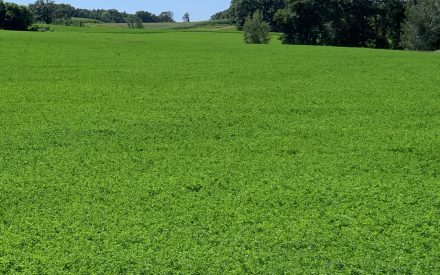 Alfalfa Fall harvest and the buildup of reserves
Alfalfa Fall harvest and the buildup of reserves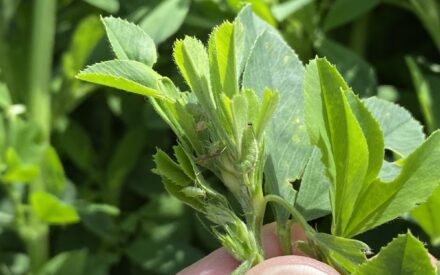 ▶ Forage Insect Pest Update
▶ Forage Insect Pest Update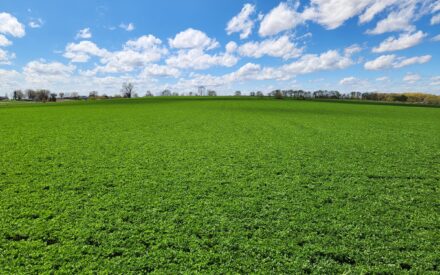 ▶ Determining the Value of Standing Forage
▶ Determining the Value of Standing Forage


